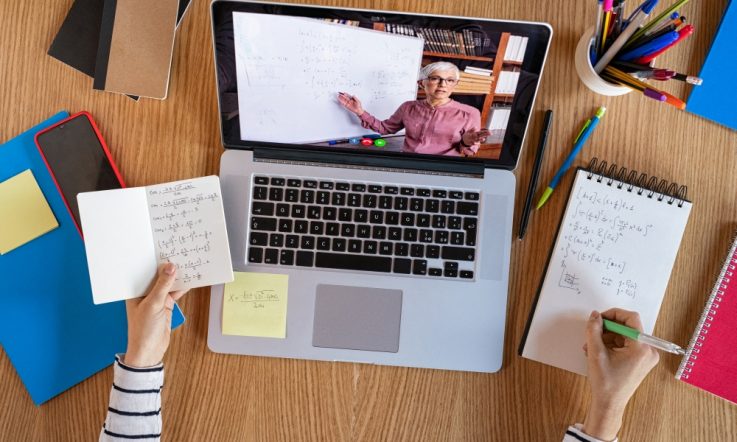Hello, and thanks for downloading this episode of Teacher Staffroom, where we catch you up on the latest evidence, insight, and action. I'm Dominique Russell.
At Teacher magazine, we love to share the research-based innovative classroom activities from educators across Australia, and the world. In today's episode I'm going to take you through some of the engaging learning activities educators have been using during this pandemic. We've heard from Arts educators, researchers in Science and teacher educators on pre-service teacher experiences. I'll take you through all of their stories in today's episode.
I'll also be posing some questions throughout this podcast, so feel free to pause the audio as you go, gather some colleagues and discuss together how these stories could be relevant to your school context. Let's jump in.
A series of research papers has been released which encourages early years educators to take advantage of teaching and learning opportunities in everyday activities to improve young children's scientific knowledge, skills and understanding. It is also designed to help early years educators incorporate the latest research into their science teaching. This has all become particularly relevant during this pandemic, because a lot of the activities outlined in the papers are ones children can complete with their parents or carers at home.
I spoke to the co-author of the series, Senior Research Fellow at the Australian Council for Educational Research, Gayl O'Connor, for an episode of The Research Files. It was a fascinating discussion about common misconceptions children might have about scientific concepts and how educators can identify them. We discussed the step-by-step activities recommended in the papers – activities like exploring plants, mixing liquids, floating and sinking, and light and shadows and how these can develop children's science skills. We also spoke about the value of integrating science in the early years, for example with English or Mathematics, and how teachers can build their own confidence with science together with the children. Here's Gayl on how this confidence can develop:
The children's confidence grows as the educator's confidence grows by starting in really simple ways. And they're just the things the educators are already doing in good practice, where they're saying “okay children, we're going to explore what's happening in the garden this week”. And the children will go and do that through their natural curiosity. … So it's just looking for those everyday prompts which you don't need any really deep scientific understanding about it, it's the building up of those scientific skills – looking, observing, making sense of what you're seeing, and starting to hypothesise – “oh, what might be happening” and “why?”
So what Gayl said just there brings me to something to think about. As an early years educator: what strategies do you use to monitor children's science understanding? Do you use the knowledge you've gained to discuss and correct any misconceptions with young learners? How does your knowledge of what children can do and understand inform your future planning?
Another area of learning which is greatly enhanced by hands-on, practical learning activities is the Arts. Being able to continue this during the pandemic has been no easy feat. Teacher educators Kate Coleman and Abbey MacDonald submitted two articles to Teacher on this topic – the first instalment shared some innovative ways visual arts teachers have connected and communicated with students while learning remotely; and the second discussed what they've learnt while teaching from home.
‘Australian arts educators responded quickly to meet the need for creative, collaborative and critical engagement opportunities for students' visual art learning at home; catering for online, offline and off device needs,' they wrote. They go on to discuss some of the curriculum concepts that underpin the work done with school students in visual art contexts, and how navigating COVID-19 has resonated with them. As well as these, they discussed how students in initial teacher education courses adapted to this unexpected interruption to their learning. Here's what they had to say about that unique challenge:
Initial teacher education courses had their own shifts to navigate online, and with that shift came a rethink in the learning and teaching as an authentic experience for building the needs of the future classroom. … These pre-service teachers all developed 30-minute digital learning experiences for remote and home learning delivered online for self-paced inquiry-based learning. A focus on making and responding through being an artist and audience outside of the art room enabled space to focus on a skills gap in digital technologies; empowering the teacher candidates to re-think and re-imagine how ways of being online can facilitate transformative learning experiences through blended and flipped learning in the future.
It's a really interesting point there. So, have a think about how you have re-thought and re-imagined ways of being online and how that could facilitate transformative learning experiences. Have you discussed these ideas with colleagues? What have been some of the common challenges? Are there any ways of connecting and communicating that you will take forward into your everyday practice as student return to the classroom environment?
It's certainly an interesting time for pre-service teachers, particularly for those undergoing a placement in a school during the transition to learning from home. Teacher's deputy editor, Rebecca Vukovic, had a really interesting discussion with Associate Professor Miriam Tanti, Acting Head of the School of Education at Australian Catholic University and Campus Dean. She said pre-service teachers and their lecturers have transitioned quite successfully to online teaching and learning, and most in their final year have been able to continue with their placements as planned. She had this to say:
As with any placement, it is context dependent – so if school is face-to-face, then pre-service teachers have engaged in this way. If schools are engaging in learning online then our pre-service teachers have engaged in this way. Pre-service teachers are guided by their teacher/mentors.
Pre-service teachers have relied on their teacher mentors to assist them during this time. So that brings me to something to think about – as a teacher mentor, what were some of the challenges you needed to overcome to best support your pre-service teacher? Was there anything you found particularly difficult? What were some of the positive outcomes?
Now, as teachers and students have begun returning to school, readers have been getting in touch to tell us what's been happening in their own school contexts. We welcome submissions from anyone in the education community – whatever sector, position or location you might be in. To see how you can get involved and read our submission guidelines, visit the submissions and feedback page at our website, teachermagazine.com.au.
In a series of three articles, we shared the stories of three Teacher readers. They covered tackling the design challenges of delivering Geography and PE to students learning from home; an international perspective on teaching through a pandemic; and the perspective from an educator at a school in regional Australia.
In the first instalment, Melbourne teacher Kristy Forrest discussed some design challenges faced in her school, and what their online solution was. For example, Kristy had this to say about a design challenge they were confronted with for PE students:
Faced with the situation of having no access to sporting facilities for several weeks, in addition to new circumstances where students would be restricted in their capacity to exercise (plus remaining sedentary for more hours of the day) the PE staff saw quarantine as an opportunity to construct a sustained assessment task that enabled them to offer a more differentiated and individualised experience than would be possible in normal classes.
She goes on to discuss that this involved designing their unit of teaching around a specific core learning intention: To develop and implement strategies that assist you to achieve Australia's 24 Hour Movement Guidelines. Students were tasked with developing a seven-minute muscle and bone strengthening workout, developing a 20-minute aerobic workout targeting a particular area of interest and completing a reflective journal of physical activity levels, including explanation of design choices for their programs, justification for their aims of the session with clear links to curriculum.
So, this brings up another interesting point on the innovative learning activities we've seen during the pandemic. Think about one of the challenges you and your colleagues overcame in providing teaching and learning activities during the lockdown. What were the desired learning outcomes? Were students able to achieve these outcomes? Were there any alternative outcomes?
Next we heard from Kate Hill – an Australian teacher from Melbourne who is currently teaching Year 7 and 8 English at Braeburn School in Nairobi, Kenya. She gave us an international perspective on learning during the pandemic. In the article, she describes what has been found from the student and parent surveys they have administered while students are learning from home. She had this to say:
What is perhaps most evident from the feedback, is that children with additional needs are facing the most challenges. Braeburn's Inclusion Leader Ana Low says that: ‘Despite many of our students being able to access the technology, active participation with teachers and peers is really how many learn best.' She reports that organisational skills, access to content, and social isolation are some of the challenges our students are facing.
That was Kate Hill there. And finally, Assistant Principal at Wodonga Senior Secondary College, Michael Rosenbrock wrote about the experience at his school community in regional Victoria. It was great to read about the perspective of a school leader who had also dealt with the impact of the bushfire crisis earlier this year. In the article, he covered their school's initial response to COVID-19, how they led teaching and learning online, supporting students and staff, and how they adjusted things along the way.
One point I found particularly interesting was when Michael spoke about how they were still prioritising professional development during the pandemic. He had this to say:
Staff were surveyed on their professional learning needs for remote learning and an extensive internal program was run on the available pupil free day. Each staff member was linked with someone on the College Executive for regular wellbeing check-ins. Being able to create video meetings via Teams proved invaluable: making running professional development easy; allowing staff to communicate; and supporting everyone to remain connected by ‘seeing' each other via video.
So as you can see, we've been hearing lots about different experiences at different schools during remote teaching and what school staff are learning throughout the whole process. So, how are you collecting evidence on the experience of students and their parents and carers during this time? How does their feedback inform your own planning and practice? We'd love to hear from you – you can get in touch with the team on Twitter or Facebook, or by email at teachereditorial@acer.org.
That's all for this episode, and you're now all caught up on the latest in evidence, insight and action in education. Links to all the content and resources I've mentioned will be in the transcript of this podcast, available at our website, teachermagazine.com.au.



